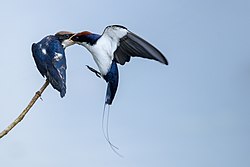Swallow
| Swallow | |
|---|---|
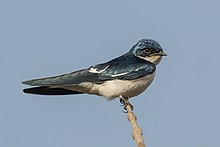
| |
| Pied-winged swallow Hirundo leucosoma | |
| Scientific classification | |
| Domain: | Eukaryota |
| Kingdom: | Animalia |
| Phylum: | Chordata |
| Class: | Aves |
| Order: | Passeriformes |
| Suborder: | Passeri |
| Family: | Hirundinidae Rafinesque, 1815 |
| Genera | |
|
19, see text | |
The swallows, martins, and saw-wings, or Hirundinidae are a family of
This family comprises two subfamilies:
Taxonomy and systematics
The family Hirundinidae was introduced (as Hirundia) by the French
Within the family, a clear division exists between the two subfamilies, the Pseudochelidoninae, which are composed of the two species of river martins,
Description
The Hirundinidae have an evolutionarily conservative body shape, which is similar across the clade, but is unlike that of other passerines.[10] Swallows have adapted to hunting insects on the wing by developing a slender, streamlined body and long, pointed wings, which allow great maneuverability and endurance, as well as frequent periods of gliding. Their body shapes allow for very efficient flight; the metabolic rate of swallows in flight is 49–72% lower than equivalent passerines of the same size.[12]

Swallows have two foveae in each eye, giving them sharp lateral and frontal vision to help track prey. They also have relatively long eyes, with their length almost equaling their width. The long eyes allow for an increase in visual acuity without competing with the brain for space inside of the head. The morphology of the eye in swallows is similar to that of a raptor.[13]
Like the unrelated
Their legs are short, and their feet are adapted for perching rather than walking, as the front toes are partially joined at the base. Swallows are capable of walking and even running, but they do so with a shuffling, waddling gait.[18] The leg muscles of the river martins (Pseudochelidon) are stronger and more robust than those of other swallows.[10][18] The river martins have other characteristics that separate them from the other swallows. The structure of the syrinx is substantially different between the two subfamilies;[8] and in most swallows, the bill, legs, and feet are dark brown or black, but in the river martins, the bill is orange-red and the legs and feet are pink.[10]
The most common hirundine plumage is glossy dark blue or green above and plain or streaked underparts, often white or rufous. Species that burrow or live in dry or mountainous areas are often matte brown above (e.g. sand martin and crag martin). The sexes show limited or no sexual dimorphism, with longer outer tail feathers in the adult male probably being the most common distinction.[19]
The chicks hatch naked and with closed eyes.[20] Fledged juveniles usually appear as duller versions of the adult.[3]
Distribution and habitat
The family has a worldwide cosmopolitan distribution, breeding on every continent except Antarctica. One species, the Pacific swallow, occurs as a breeding bird on a number of oceanic islands in the Pacific Ocean,[21] the Mascarene martin breeds on Reunion and Mauritius in the Indian Ocean,[22] and a number of migratory species are common vagrants to other isolated islands and even to some sub-Antarctic islands and Antarctica.[23] Many species have enormous worldwide ranges, particularly the barn swallow, which breeds over most of the Northern Hemisphere and winters over most of the Southern Hemisphere.
The family uses a wide range of habitats. They are dependent on flying insects, and as these are common over waterways and lakes, they frequently feed over these, but they can be found in any open habitat, including grasslands, open woodland, savanna, marshes, mangroves, and scrubland, from sea level to high alpine areas.[10] Many species inhabit human-altered landscapes, including agricultural land and even urban areas. Land-use changes have also caused some species to expand their range, most impressively the welcome swallow, which began to colonise New Zealand in the 1920s, started breeding in the 1950s, and is now a common landbird there.[24]
Species breeding in temperate regions
Behaviour and ecology

Swallows are excellent flyers and use these skills to feed and attract mates. Some species, such as the mangrove swallow, are territorial, whereas others are not and simply defend their nesting sites. In general, the male selects a nest site, and then attracts a female using song and flight and (dependent on the species) guards his territory. The size of the territory varies depending on the species of swallow; in colonial-nesting species, it tends to be small, but it may be much larger for solitary nesters. Outside the breeding season, some species may form large flocks, and species may also roost communally. This is thought to provide protection from predators, such as sparrowhawks and hobbies.[10] These roosts can be enormous; one winter-roosting site of barn swallows in Nigeria attracted 1.5 million individuals.[29] Nonsocial species do not form flocks, but recently fledged chicks may remain with their parents for a while after the breeding season. If a human being gets too close to their territory, swallows attack them within the perimeter of the nest. Colonial species may mob predators and humans that are too close to the colony.[30]
Diet and feeding
For the most part, swallows are insectivorous, taking flying insects on the wing.[10] Across the whole family, a wide range of insects is taken from most insect groups, but the composition of any one prey type in the diet varies by species and with the time of year. Individual species may be selective; they do not scoop up every insect around them, but instead select larger prey items than would be expected by random sampling.[31] In addition, the ease of capture of different insect types affects their rate of predation by swallows.[32] They also avoid certain prey types; in particular, stinging insects such as bees and wasps are generally avoided. In addition to insect prey, a number of species occasionally consume fruits and other plant matter. Species in Africa have been recorded eating the seeds of Acacia trees, and these are even fed to the young of the greater striped swallow.[10][33]
The swallows generally forage for prey on the wing, but they on occasion snap prey off branches or on the ground. The flight may be fast and involve a rapid succession of turns and banks when actively chasing fast-moving prey; less agile prey may be caught with a slower, more leisurely flight that includes flying in circles and bursts of flapping mixed with gliding. Where several species of swallows feed together, they separate into different
Breeding
The more primitive species nest in existing cavities, for example in an old
Pairs of mated swallows are monogamous,[38] and pairs of nonmigratory species often stay near their breeding area all year, though the nest site is defended most vigorously during the breeding season. Migratory species often return to the same breeding area each year, and may select the same nest site if they were previously successful in that location. First-year breeders generally select a nesting site close to where they were raised.[39] The breeding of temperate species is seasonal, whereas that of subtropical or tropical species can either be continuous throughout the year or seasonal. Seasonal species in the subtropics or tropics usually time their breeding to coincide with the peaks in insect activity, which is usually the wet season, but some species, such as the white-bibbed swallow, nest in the dry season to avoid flooding in their riverbank nesting habitat.[10] All swallows defend their nests from egg predators, although solitary species are more aggressive towards predators than colonial species.[40] Overall, the contribution of male swallows towards parental care is the highest of any passerine bird.[10]
The
The chicks of swallows hatch naked, generally with only a few tufts of down. The eyes are closed and do not fully open for up to 10 days. The feathers take a few days to begin to sprout, and the chicks are brooded by the parents until they are able to
Calls
Swallows are able to produce many different calls or songs, which are used to express excitement, to communicate with others of the same species, during courtship, or as an alarm when a predator is in the area. The songs of males are related to the body condition of the bird and are presumably used by females to judge the physical condition and suitability for mating of males.[41] Begging calls are used by the young when soliciting food from their parents. The typical song of swallows is a simple, sometimes musical twittering.
Status and conservation
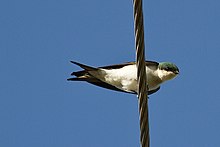
Species of hirundine that are
Relationship with humans

Swallows are tolerated by humans because of their beneficial role as insect eaters, and some species have readily adapted to nesting in and around human habitation. The barn swallow and
Because of the long human experience with these conspicuous species, many myths and legends have arisen as a consequence, particularly relating to the barn swallow.
During the 19th century, Jean Desbouvrie attempted to tame swallows and train them for use as messenger birds, as an alternative to war pigeons. The swallows would have a light load of course, as a laden swallow could only travel about half as far as an unladen swallow in the same trip. He succeeded in curbing the migratory instinct in young birds and persuaded the government of France to conduct initial testing, but further experimentation stalled.[49][51] Subsequent attempts to train homing behaviour into swallows and other passerines had difficulty establishing a statistically significant success rate, although the birds have been known to trap themselves in a cage repeatedly to get to the bait.[49]
According to a sailing superstition, swallows are a good omen to those at sea. This probably arose from the fact that swallows are land-based birds, so their appearance informs a sailor that he or she is close to shore.[52] An old term of venery for swallows is a "flight" or "sweep".[53]
Species list
The family contains 89 species in 21 genera.[54]
| Image | Genus | Species |
|---|---|---|
 |
Pseudochelidon Hartlaub, 1861 |
|
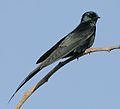 |
Psalidoprocne Cabanis, 1850 |
|
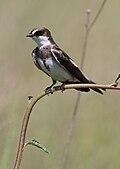 |
Neophedina Roberts, 1922 |
|
 |
Phedinopsis Wolters, 1971 |
|
 |
Phedina Bonaparte, 1855 |
|
 |
Riparia Forster,T, 1817 |
|
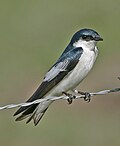 |
Tachycineta Cabanis, 1850 |
|
 |
Atticora Gould, 1842 |
|
 |
Pygochelidon Baird, SF, 1971 |
|
 |
Alopochelidon Ridgway, 1903 |
|
 |
Orochelidon Ridgway, 1903 |
|
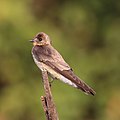 |
Stelgidopteryx Baird, SF, 1858 |
|
 |
Progne Boie, F, 1826 |
|
 |
Pseudhirundo Roberts, 1922 |
|
 |
Cheramoeca Cabanis, 1850 |
|
 |
Ptyonoprogne Reichenbach, 1850 |
|
 |
Hirundo Linnaeus, 1758 |
|
 |
Delichon Moore, F, 1854 |
|
 |
Cecropis Boie, F, 1826 |
|
| Atronanus De Silva, 2018 |
| |
 |
Petrochelidon Cabanis, 1850 |
|
References
- ^ "Swallow". Encyclopaedia Britannica.
- ISBN 9781408131725.
- ^ ISBN 978-0-395-51174-9.
- ^ Rafinesque, Constantine Samuel (1815). Analyse de la nature ou, Tableau de l'univers et des corps organisés (in French). Vol. 1815. Palermo: Self-published. p. 68.
- hdl:2246/830.
- .
- PMID 30936315.
- ^ a b Mayr, E.; Amadon, D (1951). "A Classification of Recent Birds" (PDF). American Museum Novitates (1496): 16.
- PMID 15737595.
- ^ ISBN 978-84-87334-69-6.
- PMID 8516319.
- .
- S2CID 3923166.
- ISBN 978-1-4200-6444-5.
- S2CID 86592049.
- ^ .
- S2CID 85260912.
- ^ JSTOR 4083540.
- .
- ISBN 978-0-7167-2415-5.
- ISBN 978-0-691-08402-2.
- ISBN 978-1-86872-956-2.
- .
- .
- ^ In 1878, Dr. Elliott Coues, listed titles of 182 papers dealing with the hibernation of swallows ((USGS: Northern Prairie Wildlife Research Center) "Early ideas about migration" Archived 2008-08-27 at the Wayback Machine).
- JSTOR 1365178.
- .
- S2CID 52596.
- ^ Bijlsma, R (2003). "A Barn Swallow Hirundo rustica roost under attack: timing and risks in the presence of African Hobbies Falco cuvieri" (PDF). Ardea. 93 (1): 37–48. Archived from the original (PDF) on 2008-10-31.
- S2CID 53193659.
- JSTOR 1369987.
- .
- .
- ^ .
- JSTOR 1938676.
- S2CID 21128259.
- S2CID 53185342.
- ^ Hirundinidae Archived 2002-05-04 at the Wayback Machine. eeb.cornell.edu
- ^ Swallows (Hirundinidae) Archived 2009-01-29 at the Wayback Machine. Answers.com
- JSTOR 1367096.
- .
- ^ Tobias, Joe (2000). "Little known Oriental Bird: White-eyed River-Martin: 1". Oriental Bird Club Bulletin. 31.
- S2CID 85973776.
- ^ "National symbols of Estonia". The Estonia Institute. Archived from the original on 9 November 2007. Retrieved 27 November 2007.
- ^ "Gallery of Barn Swallow stamps from Bird-Stamps.org". Archived from the original on 2020-06-09. Retrieved 2022-07-21.
{{cite web}}: CS1 maint: unfit URL (link) - ^ The American Topical Association lists more than 1000 depictions of swallows and martins on postage stamps around the world. See [1] Archived 2020-03-31 at the Wayback Machine
- ^ Wikibooks: World Catalogue of Stamps[permanent dead link]
- JSTOR 4160543.
- ^ a b c Brian, P.W. (1955). Bird Navigation. Cambridge University Press. pp. 57–58. Retrieved 2009-03-01.
- ^ "More than just a bird : Korea.net : The official website of the Republic of Korea".
- ^ Anonymous (1889). Zoologist: A Monthly Journal of Natural History, ser.3 v.13. J. Van Voorst. pp. 398–399. Retrieved 2009-03-01.
- ISBN 978-1-4081-3131-2.
- ^ "Animal Congregations, or What Do You Call a Group of.....?". USGS.gov. Northern Prairie Wildlife Research Center. Archived from the original on 20 March 2015. Retrieved 13 September 2011.
- Rasmussen, Pamela, eds. (July 2021). "Swallows". IOC World Bird List Version 11.2. International Ornithologists' Union. Retrieved 19 July 2021.
External links
- Swallow videos on the Internet Bird Collection
- The evolution of nest construction in swallows (Hirundinidae) is associated with the decrease of clutch size[permanent dead link] paper in Linzer Biologische Beiträge
 Texts on Wikisource:
Texts on Wikisource:
- "Swallows". The New Student's Reference Work. 1914.
- Newton, Alfred (1911). "Martin". In Chisholm, Hugh (ed.). Encyclopædia Britannica (11th ed.). Cambridge University Press.
- Newton, Alfred (1911). "Swallow". Encyclopædia Britannica (11th ed.).
- "New International Encyclopedia. 1905.


